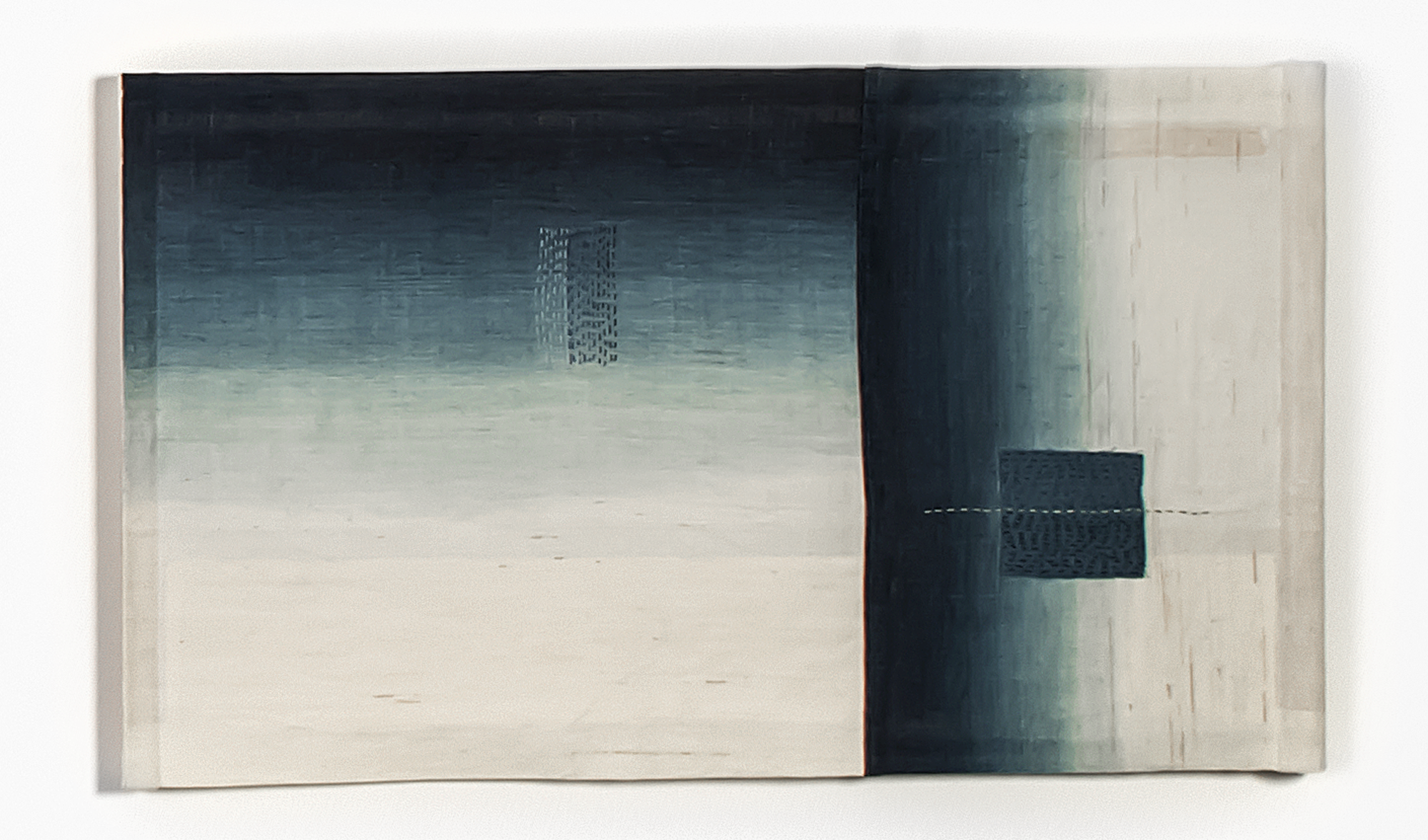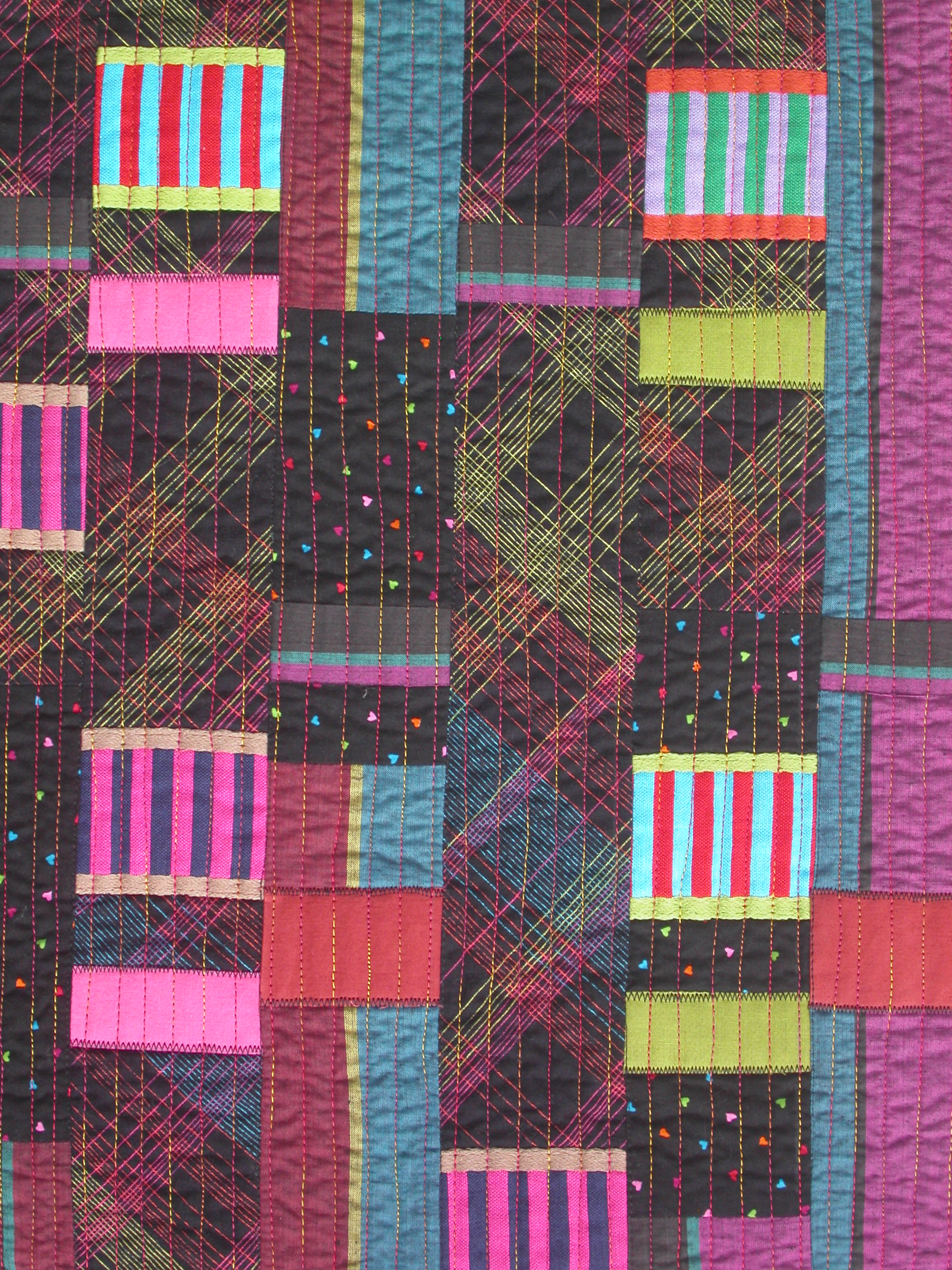Stitch, Resist, Reflect.
Akemi Nakano Cohn, Jo Ann Giordano, & Kathleen Van Meter
August 17 - October 11
Brought to you by the Kendal Gallery at Kendal at Oberlin in collaboration with FAVA
This online exhibition is in cooperation with with the Art Committee of Kendal at Oberlin and Robert Taylor, curator of the Kendal Gallery.
** Due to COVID-19, Kendal at Oberlin Galleries are not currently open to the public for in-person viewing.**
“Sunrise, Sunset Series #5 - #8”, Akemi Nakano Cohn, dyed silk, cotton, ramie with natural dyes: madder, weld cutch, logwood, marigold, lac, indigo; shibori resist technique; boro patched and hand-stitched; constructed by Japanese scroll method, 10” x 22 ½ ”, 2020, $450 each
"Sunrise, Sunset #4", Akemi Nakano Cohn, dyed silk, cotton, ramie with natural dyes: madder, weld, cutch, logwood, marigold, lac, indigo; shibori resist technique; boro patched and hand-stitched; constructed by Japanese scroll method, 22 ½” x 19 ½” 2020, $800
Detail of "Sunrise, Sunset #4"
"Sunrise, Sunset #3", Akemi Nakano Cohn, dyed silk, cotton, ramie with natural dyes: madder, weld, cutch, logwood, marigold, lac, indigo; shibori resist technique; boro patched and hand-stitched; constructed by Japanese scroll method, 22 ½” x 19 ½”, 2020, $800
Detail of "Sunrise, Sunset #3"
“Out of the Blue Series”, Akemi Nakano Cohn, natural indigo dying on ramie; boro patched and hand-stitched; constructed by Japanese scroll method, 2021

"Out of the Blue #1", Akemi Nakano Cohn, natural indigo dyeing on ramie; boro patched and hand-stitched; constructed by Japanese scroll method, 2021, $600

Detail of "Out of the Blue #1"

"Out of the Blue #2", Akemi Nakano Cohn, natural indigo dyeing on ramie; boro patched and hand-stitched; constructed by Japanese scroll method, 2021, $600

"Out of the Blue #3", Akemi Nakano Cohn, natural indigo dyeing on ramie; boro patched and hand-stitched; constructed by Japanese scroll method, $600

"Out of the Blue #4", Akemi Nakano Cohn natural indigo dyeing on ramie; boro patched and hand-stitched; constructed by Japanese scroll method, 2021, $600

Detail of "Out of the Blue #4"

"Out of the Blue #5", Akemi Nakano Cohn natural indigo dyeing on ramie; boro patched and hand-stitched; constructed by Japanese scroll method, 2021, $600

"Out of the Blue #6", Akemi Nakano Cohn, natural indigo dyeing on ramie; boro patched and hand-stitched; constructed by Japanese scroll method, 2021, $600
"Social Safety Net", JoAnn Giordano, Japanese paper, linen thread, fabric; cutting, burning, stitching, 34” x 20” x 1”, $1000
Detail of "Social Safety Net"
"Anthropocene: Wildfires", JoAnn Giordano, handmade paper, cut and painted, marbleized silk fabric, 34.5” x 24.5” x 1”, $700
Social Safety Net
Japanese paper with an embedded grid of linen threads suggested to me a sense of harmony and order. I disrupted that order by cutting into and burning the paper, revealing a layer of distressed synthetic sheer fabric. My intent is to draw attention to government cuts in the social programs benefiting the poor and needy. The dismantling of the social safety net comes with increased economic risks for American families.
Anthropocene: Wildfires
This piece is a metaphor for the human-induced causes of wildfires worldwide: climate change, increased frequency and intensity of drought, human encroachment into fire-prone areas, lack of prescribed burning, and disruption of forest ecosystems.
"Convivencia", JoAnn Giordano, fabric collage: silk and synthetic fabrics; screenprint, stitching, 37”x 28, $1000
Detail of "Convivencia"
"Carrot Portrait: Arabesque", JoAnn Giordano, Vandyke print on fabric, cotton fabrics; appliqué, embroidery, 37”x 19”, $800
Detail of "Carrot Portrait: Arabesque"
Convivencia
The period in Spanish history from the Muslim conquest in 711 until the Christian Reconquest and expulsion of the Jews in 1492 is referred to as convivencia, or “coexistence.” It was a Golden Age marked by the sharing of ideas in science, technology, art, and philosophy by the three religious groups. After the events of 9/11 and conflicts in the Middle East, my reaction was to seek harmony and cooperation amongst diverse populations.
Carrot Portrait: Arabesque
Inspired by my Vandyke printed photo on fabric of a humanoid carrot from my garden, this piece juxtaposes the organic quality of the carrot with the vegetal Islamic arabesque pattern. A visit to the Alhambra Palace in Granada, Spain sparked my interest in Islamic pattering.
"Mumbai Boogie Woogie", JoAnn Giordano, cotton fabrics and trim; piecing, appliqué, machine quilting, 39”x 29”, $900
Detail of "Mumbai Boogie Woogie"
"Elegy for Fukushima", JoAnn Giordano, fabric collage: handmade and found fabrics; screenprint, discharge, appliqué, stitching, 57” x 17”, $800, Photo Credit—Linda Grashoff
Detail of "Elegy for Fukushima", Photo Credit—Linda Grashoff
Mumbai Boogie Woogie
A recent trip to India led me to try to capture my impressions of an Indian street scene: exuberant pattern and color, fanciful trucks painted with baroque designs, the constant honking of horns, and the rhythmic road ballet of trucks, cars, motorcycles, bicycles, rickshaws and cattle.
Elegy for Fukushima
My response to the 2011 nuclear disaster in Japan: horror at the news of reactor meltdown, endless fires, and radioactive contamination of the environment. I chose fabrics for their symbolic and expressive value: handprinted, bleached, Japanese print. Layering of imagery and fabrics adds surface complexity and speaks to the cover-up by industry and government.
** Photo Credit and special thanks to—Linda Grashoff, for photographing all of the following images of Kathleen Van Meter’s textile works.**
"Wind Swept", Kathleen Van Meter, fiber, 2019, $175
Detail of "Wind Swept"
"Layer after Layer", Kathleen Van Meter, fiber, 2020, NFS
Detail of "Layer after Layer"
“Quiet Strength”, Kathleen Van Meter, fiber, 2019, $175
Detail of “Quiet Strength”
"Whispers of Autumn", Kathleen Van Meter, fiber, 2019, SOLD
Detail of "Whispers of Autumn", SOLD
"Convergence", Kathleen Van Meter, fiber, 2020, $250
Detail of "Convergence"
"Layer after Layer", Kathleen Van Meter, fiber, 2020, NFS
Detail of "Layer after Layer"
"Indigo Glow", Kathleen Van Meter, fiber, 2020, $400
Detail of "Indigo Glow"
"Accessory Threads", Kathleen Van Meter, fiber, 2019, $250
Detail of "Accessory Threads"
"Centering", Kathleen Van Meter, fiber, 2020, $175
Detail of "Centering"
"Spring’s Arrival", Kathleen Van Meter, fiber, 2019, $175
Detail of "Spring’s Arrival"
"Stitched Within", Kathleen Van Meter, fiber, 2020, SOLD
Detail of "Stitched Within", SOLD
"Within", Kathleen Van Meter, fiber, 2019, $175
Detail of "Within"
"Mindful Balance", Kathleen Van Meter, fiber, 2020, $175
Detail of "Mindful Balance"
Artist Talk
Featuring:
Akemi Nakano Cohn
Jo Ann Giordano
Kathleen Van Meter
Brought to you by the Kendal Gallery at Kendal at Oberlin.
Akemi Nakano Cohn (Chicago, IL)
Artist Statement:
Sunrise, Sunset series is inspired by the Buddhist belief of the cycle of life which emphasizes repetition, like sunrise and sunset in the natural world.
It repeats again and again to give new life.
I have been exploring and using natural dyes exclusively in my pieces allowing the materials to represent my thoughts. I extract dyes from live flowers, plants, and roots, such as Marigold, apple tree, Osage, Weld, Logwood, Madder, etc. I use color solution to dye silk fabrics. Even though flowers are ephemeral and only live for a short time, the color extracted from them will stay on the fabric after the flowers are gone. It indicates a new life of the flower.
Out of The Blue series was made during the Corona pandemic. Although I usually work alone in my studio, my surroundings have been quiet and isolated with no visitors or interruptions. I started dyeing fabric using natural indigo dye vat. Various shades of indigo blue represent sky, water, waves, and ocean. I felt infinite space and freedom. At the same time, blue has a melancholic connotation, and it made me think of people who suffered from the Corona pandemic. I applied traditional Japanese “Boro” mending and repairing technique wishing to repair and return our peaceful life.
Hand stitching was used as a pattern-repeat in both series.
As the act of stitching is like breathing, the repetitive action calmed me. Since it is an extremely slow process, I felt I am meditating in search of peace of mind.
It is a perfect way to relax during a difficult time.
Bio:
Cohn was born in Yokohama, Japan. She studied traditional Japanese dyeing techniques for ten years under the master, Haru Izumi in Japan. She has an MFA in Fiber Art from Cranbrook Academy of Art. Cohn has taught at the School of the Art Institute of Chicago, as well as workshops at Haystack, Penland, Arrowmont, Int’l Surface Design Conference, and Zijdelings (Netherlands). Her national and international exhibits include the Museum of Arts and Design(NY), The Bellevue Arts Museum(WA), University of Nebraska, Penland Gallery, and Gallery Uesuto(Japan). She has been an artist-in-residence at Anderson Ranch, and Ragdale Foundation. She was selected scholar-in-residence by SEEDS Arts and Education Program in 2016. Commissions include Unitarian Church of Evanston, Loyola University Medical Center, At Home Co.Ltd. She lives in Chicago, IL.
www.akemistudio.com jackemi@rcn.com www.akeminakanocohn.blogspot.com
JoAnn Giordano (South Euclid, Ohio)
JoAnn Giordano, who lives in South Euclid, Ohio, is an artist and retired educator who recently completed 26 years of teaching textile art classes as adjunct faculty at Case Western Reserve University and Kent State University. She also taught community arts classes and workshops for both children and adults. Giordano earned a BFA at Rhode Island School of Design, an MA at Purdue University, and an MFA in Fiber at Cranbrook Academy of Art in Michigan.
She has been working in the textile medium for more than 45 years and has exhibited her artwork nationally since 1977. She was awarded an Ohio Arts Council Individual Artist Fellowship in 1995. Her work has been published in Fiberarts magazine, in Surface Design Journal, and in the books Surface Designer’s Art, Imagery on Fabric, and Uncommon Threads. She is represented in many public and private collections in the Midwest.
“As the granddaughter of a custom tailor,” she says, “I was exposed to textiles at an early age. Historical textiles and decorative art featuring pattern and narrative inform my artwork. A collage sensibility impels me to collect diverse images and materials that are used for their expressive potential in a specific narrative or concept. The narrative may express societal, political, or envi-ronmental issues, or more personal themes, such as my fascination with world cultures and travel.
“As a result of many years of teaching textile art, I have extensively explored surface design on fabric: printing, dyeing, bleaching, piecing, quilting. My home studio is filled with a treasure trove of fabrics, both found and handmade, that beckon me to realize their potential.”
Kathleen Van Meter (North Ridgeville, Ohio)
“My recent body of work,” she says, “combines a variety of indigo-dyed fabric and reclaimed textiles with sashiko stitching. Sashiko is a form of Japanese traditional stitching developed to mend, strengthen, and decorate.”
Kathleen Van Meter, received a BFA in Fiber Textiles from the Cleveland Institute of Art. Her works have been included in a number of shows in Ohio, including the Textile Art Alliance Members Show in Pepper Pike, the Annual May Show at Lakeland, The Artist as Quiltmaker in Oberlin, the Cleveland Museum of Art, the Morgan Conservatory in Cleveland, the Artists Archives of the Western Reserve in Cleveland, Cleveland Botanical Garden, the Nicholson B. White Gallery in Cleveland, Praxis Gallery in Cleveland, the Canton Museum of Art, Translations Art Gallery in Canton, Cuyahoga Community College in Parma, Coburn Gallery in Ashland, Lakeland Community College, Beck Center for the Arts in Lakewood, Gelbke Fine Arts Center in Hiram, the Stocker Art Gallery in Elyria, the Artseen Gallery in Vermilion, the Ohio Craft Museum in Columbus, and Ginko Gallery and Studio on Oberlin.
She has also shown in cities all across the United States, including Indianapolis, Indiana; Ann Arbor and Flint, Michigan; St. Louis and Kansas City, Missouri; Santa Fe, New Mexico; St. Bonaventure, New York; Greensboro, North Carolina; Grants Pass, Oregon; Pittsburgh, Pennsylvania; and Lowell, Massachusetts.


















































